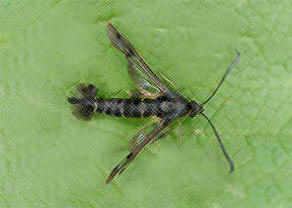Clearwing moths - Synanthedon tipuliformis Clerck - are normally noticed on Black Currant, red Currants and Gooseberries as a result of dead or dying shoots. It is one of the smaller moths, with a total wingspan of no more that 18mm. As the wings are transparent – other than a dark orange leading edge, but also with some black markings, and it flies by day, it is not too easy to spot.
It is said to affect raspberries, but we have found no evidence of this.
The body is quite distinctive – if rather small – generally dark brown with three narrow yellow girth rings. This sometimes leads to a mistaken identification of wasp or hover fly.
Damage is normally noticed in late summer, as the Clearwing Moth lays its eggs in June. It normally starts laying eggs within 15 days of emergence from the pupae stage within the host plant. There is but one egg laying generation per year. It is normally in its winged stage of the life cycle between May and July each year.
 Clearwing Moth - showing the wings that give it it's name.
Clearwing Moth - showing the wings that give it it's name.
The eggs hatch within 2 weeks and the caterpillars bore into the stem and live happily on the pithy centre throughout the year until the following spring, when the cycle starts again with the moth emerging from the stem from within which the larvae pupate and over-winter..
Wilting will occur in late summer – well before autumn leaf colour change. It is normal for the young shoots to wither and die, as the damage of the larva affects sap flow.
There is a very limited timespan for use of chemical control, and this in any event coincides with the early harvest time of these crops. therefore chemical control by insecticide is not an option. Together with that, there are no chemicals available for the amateur gardener for controlling this pest.
Pheremone traps have been trialled in order to interrupt the mating activities of the moth and has resulted in significant success. These trials have been carried out on large scale operations, so it is unclear how the practical inclusion will help the small allotment grower.
Clearwing Moth is not a huge problem unless you are a commercial grower, so best treatment is to cut back the affected stems to good green growth, and burn.
There is a natural parasite of the Clearwing Moth in European countries, and it is thought that a balance can be achieved naturally without intervention by man. Much depends upon the value placed o the crop by the grower.
There are many Clearwing Moth types in the UK, and this particular moth should not be confused with the Clearwing Hummingbird Moth.
The Blackcurrant Clearwing moth is more like a small wasp - but with a dark body. Whilst it is a day-flying moth, it is rarely noticed because of its insignificance and small size. Looks like many other small flies and hover wasps to be found in the garden.
Other Blackcurrant Pests | Blackcurrant Leaf gall Midge - is different to Big Bud Mite. | Aphids |
Main Page for Apple Tree Problems